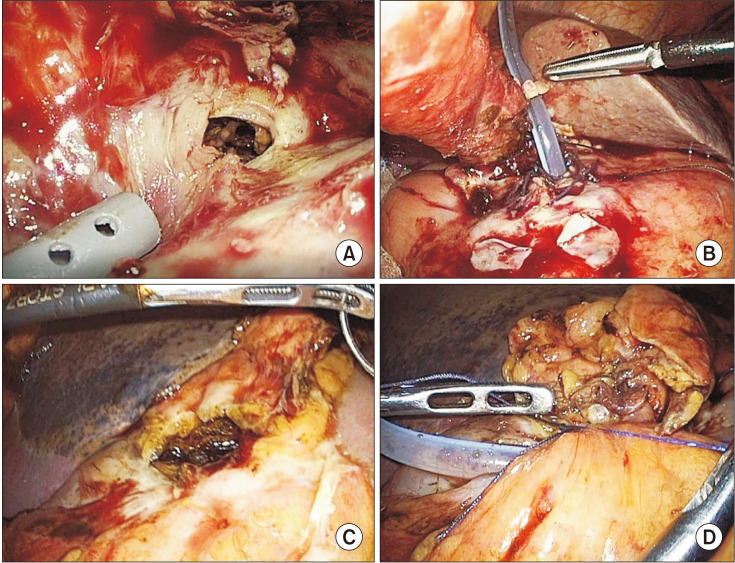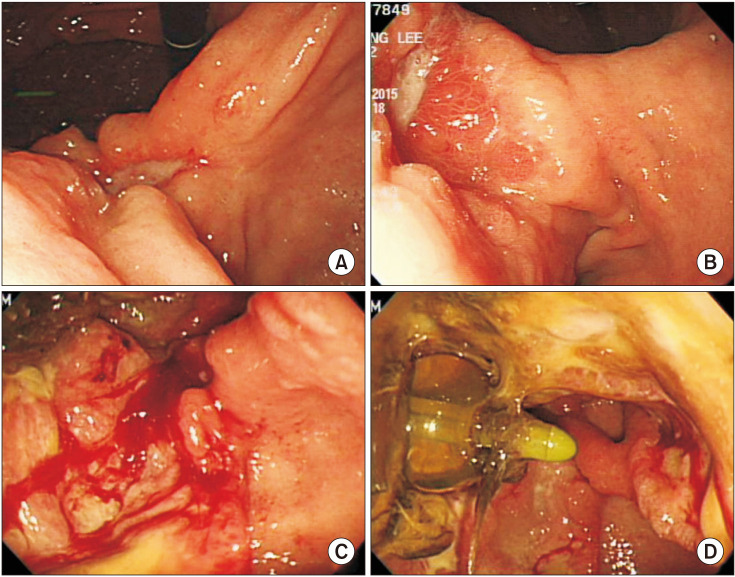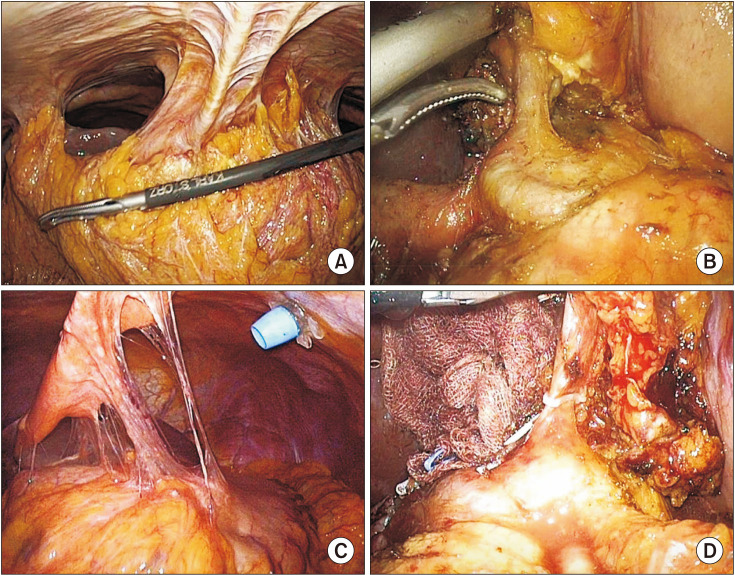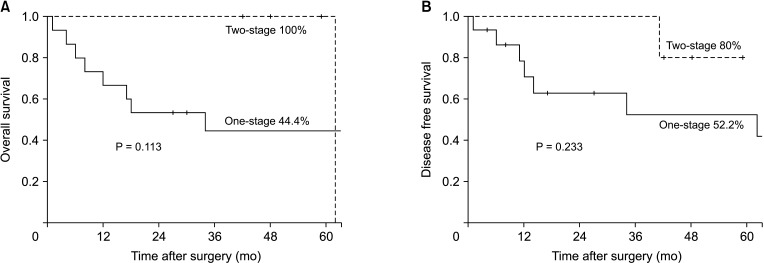Ann Surg Treat Res.
2021 Sep;101(3):151-159. 10.4174/astr.2021.101.3.151.
The role of laparoscopic management in perforated gastric cancer
- Affiliations
-
- 1Department of Surgery, Yeouido St. Mary’s Hospital, College of Medicine, The Catholic University of Korea, Seoul, Korea
- 2Department of Surgery, Eunpyeong St. Mary's Hospital, College of Medicine, The Catholic University of Korea, Seoul, Korea
- KMID: 2519845
- DOI: http://doi.org/10.4174/astr.2021.101.3.151
Abstract
- Purpose
Perforated gastric cancer is an extremely rare condition and usually presents in advanced stage with poor prognosis. Surgical strategies are still controversial regarding the extent to which complete resection or primary repair is performed and the application of laparoscopic techniques. We aim to determine the role of laparoscopic 2-stage approach in perforated gastric cancer.
Methods
Among 2,318 gastric cancers in Yeouido St. Mary’s Hospital from January 1990 to December 2017, 20 patients with perforated gastric cancer were enrolled, and 5 patients underwent 2-stage gastrectomy consisting of primary closure on perforation followed by curative gastrectomy. Clinicopathological features, surgical outcomes, and survival analysis were evaluated.
Results
Two-stage approach for perforated gastric cancer was all performed by laparoscopic approach except 1 patient who needed paraaortic lymph node dissection (LND). Those were first treated on peritonitis with laparoscopic primary closure with or without Foley gastrostomy. Compared to 1-stage gastrectomy, more D2 LND was performed (60.0% vs. 100.0%, P = 0.260) and retrieved lymph nodes were significantly higher (median [range]: 17.0 [12.0–27.0] vs. 33.0 [26.5–43.5], P = 0.019]. Two patients of stage II and 3 patients of stage III were included in the 2-stage gastrectomy group. During the 38 months of median follow-up period, there were 8 and 1 recurrence among 1-stage and 2-stage gastrectomies, respectively. Except for 1 patient, 4 other 2-stage patients survived around 5 years without recurrence (5-year disease-free survival, 80%).
Conclusion
Laparoscopic 2-stage surgery for perforated gastric cancer is safe and might increase the curability of gastrectomy with extended LND.
Figure
Reference
-
1. Information Committee of Korean Gastric Cancer Association. Korean Gastric Cancer Association Nationwide Survey on Gastric Cancer in 2014. J Gastric Cancer. 2016; 16:131–140. PMID: 27752390.2. Jeong O, Park YK. Clinicopathological features and surgical treatment of gastric cancer in South Korea: the results of 2009 nationwide survey on surgically treated gastric cancer patients. J Gastric Cancer. 2011; 11:69–77. PMID: 22076206.
Article3. Kang KJ, Lee JH. Characteristics of gastric cancer in Korea: with an emphasis on the increase of the early gastric cancer (EGC). J Korean Med Assoc. 2010; 53:283–289.4. Ignjatovic N, Stojanov D, Djordjevic M, Ignjatovic J, Benedeto Stojanov D, Milojkovic B. Perforation of gastric cancer: what should the surgeon do? Bosn J Basic Med Sci. 2016; 16:222–226. PMID: 27131023.5. Mahar AL, Brar SS, Coburn NG, Law C, Helyer LK. Surgical management of gastric perforation in the setting of gastric cancer. Gastric Cancer. 2012; 15(Suppl 1):S146–S152. PMID: 21983994.
Article6. Lehnert T, Buhl K, Dueck M, Hinz U, Herfarth C. Two-stage radical gastrectomy for perforated gastric cancer. Eur J Surg Oncol. 2000; 26:780–784. PMID: 11087645.
Article7. Wang SY, Hsu CH, Liao CH, Fu CY, Ouyang CH, Cheng CT, et al. Surgical outcome evaluation of perforated gastric cancer: from the aspects of both acute care surgery and surgical oncology. Scand J Gastroenterol. 2017; 52:1371–1376. PMID: 28838270.
Article8. Hata T, Sakata N, Kudoh K, Shibata C, Unno M. The best surgical approach for perforated gastric cancer: one-stage vs. two-stage gastrectomy. Gastric Cancer. 2014; 17:578–587. PMID: 24122093.
Article9. Melloni M, Bernardi D, Asti E, Bonavina L. Perforated gastric cancer: a systematic review. J Laparoendosc Adv Surg Tech A. 2020; 30:156–162. PMID: 31545122.
Article10. Tegels JJ, De Maat MF, Hulsewé KW, Hoofwijk AG, Stoot JH. Improving the outcomes in gastric cancer surgery. World J Gastroenterol. 2014; 20:13692–13704. PMID: 25320507.11. Best LM, Mughal M, Gurusamy KS. Laparoscopic versus open gastrectomy for gastric cancer. Cochrane Database Syst Rev. 2016; 3:CD011389. PMID: 27030300.
Article12. Son T, Hyung WJ. Laparoscopic gastric cancer surgery: current evidence and future perspectives. World J Gastroenterol. 2016; 22:727–735. PMID: 26811620.
Article13. Adachi Y, Mori M, Maehara Y, Matsumata T, Okudaira Y, Sugimachi K. Surgical results of perforated gastric carcinoma: an analysis of 155 Japanese patients. Am J Gastroenterol. 1997; 92:516–518. PMID: 9068483.14. Cortese AF, Zahn D, Cornell GN. Perforation in gastric malignancy. J Surg Oncol. 1972; 4:190–206. PMID: 4560766.
Article15. Tsujimoto H, Hiraki S, Sakamoto N, Yaguchi Y, Horio T, Kumano I, et al. Outcome after emergency surgery in patients with a free perforation caused by gastric cancer. Exp Ther Med. 2010; 1:199–203. PMID: 23136615.
Article16. Kotan C, Sumer A, Baser M, Kızıltan R, Carparlar MA. An analysis of 13 patients with perforated gastric carcinoma: a surgeon's nightmare? World J Emerg Surg. 2008; 3:17. PMID: 18471321.
Article17. Roviello F, Rossi S, Marrelli D, De Manzoni G, Pedrazzani C, Morgagni P, et al. Perforated gastric carcinoma: a report of 10 cases and review of the literature. World J Surg Oncol. 2006; 4:19. PMID: 16573818.
Article18. Mukai M, Kondou Y, Ogoshi K, Noto T, Makuuchi H, Tajima T, et al. A case of perforated early gastric cancer and a review of 45 cases collected from the Japanese literature. J Jpn Practic Surg Soc. 1992; 53:1869–1873.
Article19. Lee HJ, Park DJ, Yang HK, Lee KU, Choe KJ. Outcome after emergency surgery in gastric cancer patients with free perforation or severe bleeding. Dig Surg. 2006; 23:217–223. PMID: 16874002.
Article20. Ozmen MM, Zulfikaroglu B, Kece C, Aslar AK, Ozalp N, Koc M. Factors influencing mortality in spontaneous gastric tumour perforations. J Int Med Res. 2002; 30:180–184. PMID: 12025526.
Article21. Agarwal N, Malviya NK, Gupta N, Singh I, Gupta S. Triple tube drainage for “difficult” gastroduodenal perforations: a prospective study. World J Gastrointest Surg. 2017; 9:19–24. PMID: 28138365.
Article22. Gutt CN, Oniu T, Schemmer P, Mehrabi A, Büchler MW. Fewer adhesions induced by laparoscopic surgery? Surg Endosc. 2004; 18:898–906. PMID: 15108105.
Article23. Brüggmann D, Tchartchian G, Wallwiener M, Münstedt K, Tinneberg HR, Hackethal A. Intra-abdominal adhesions: definition, origin, significance in surgical practice, and treatment options. Dtsch Arztebl Int. 2010; 107:769–775. PMID: 21116396.
- Full Text Links
- Actions
-
Cited
- CITED
-
- Close
- Share
- Similar articles
-
- Laparoscopic Surgery for Gastric Cancer
- Laparoscopic Surgery for Advanced Gastric Cancer: Current Status and Future Perspectives
- Intracorporeal Anastomosis in Laparoscopic Gastric Cancer Surgery
- Entirely Laparoscopic Gastrectomy and Colectomy for Remnant Gastric Cancer with Gastric Outlet Obstruction and Transverse Colon Invasion
- The Current Status and Future Perspectives of Laparoscopic Surgery for Gastric Cancer





